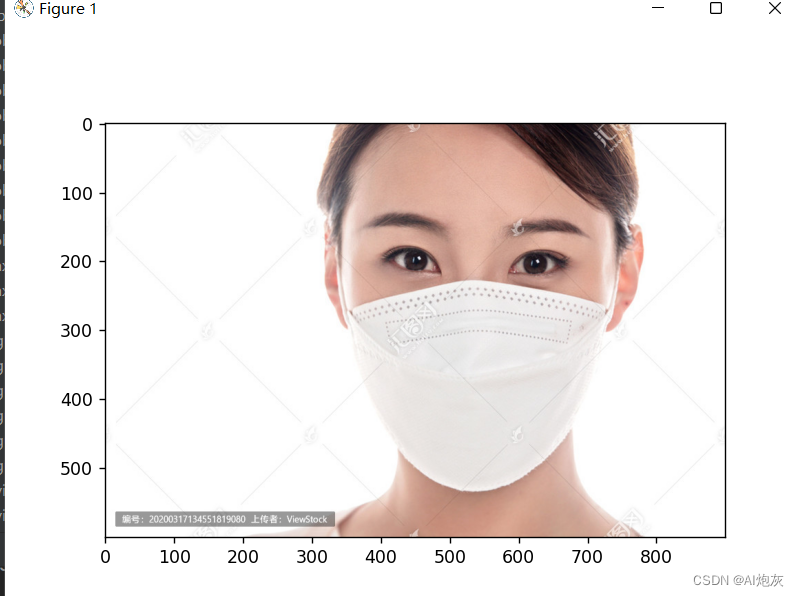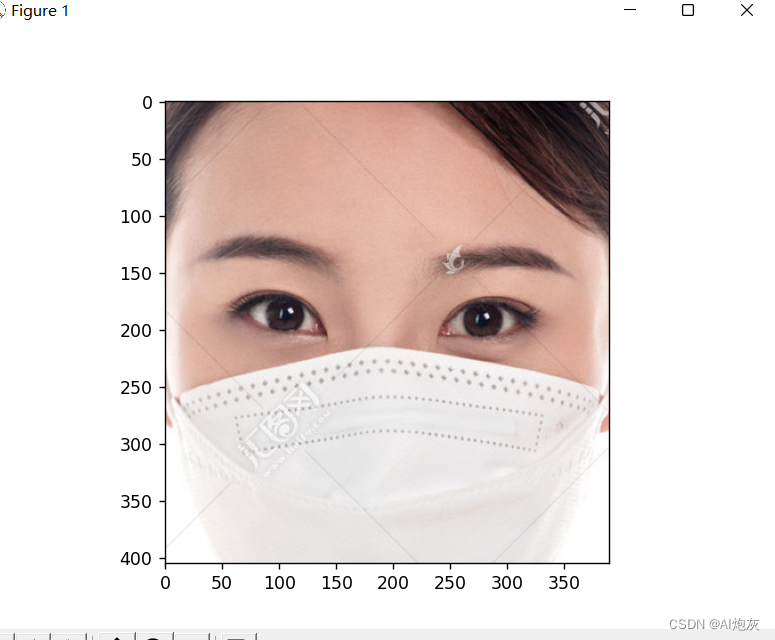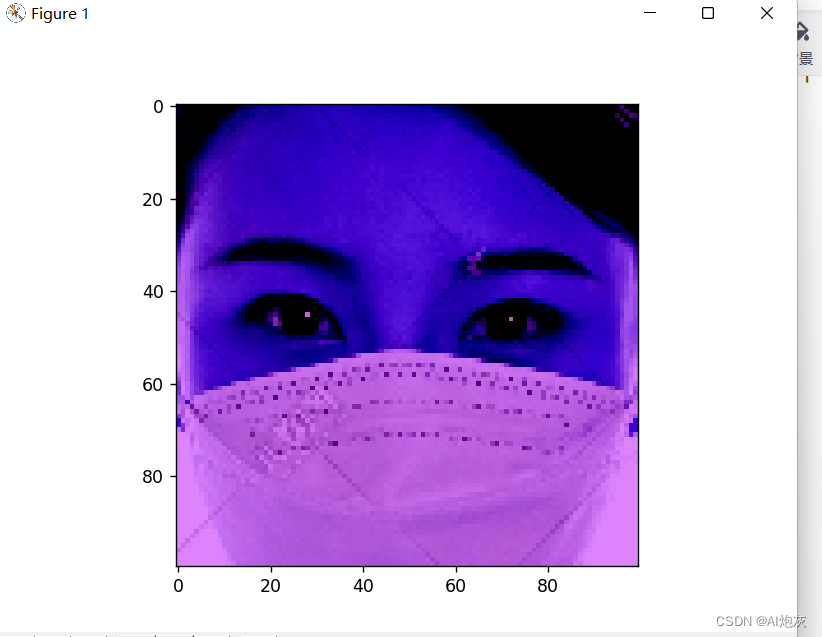独热编码官方合作微信:gldz_super
本专栏《AI计算机视觉进阶项目》主要以计算机视觉实战项目为主,第一个项目为口罩检测:该项目将分为几个模块进行展示。本项目已完成链接:
1.AI计算机视觉进阶项目(一)——带口罩识别检测(1)_AI炮灰的博客-CSDN博客
2.AI计算机视觉进阶项目(一)——带口罩识别检测(2)_AI炮灰的博客-CSDN博客
3.AI计算机视觉进阶项目(一)——带口罩识别检测(3)_AI炮灰的博客-CSDN博客
一、本节概述
对AI计算机视觉进阶项目(一)——带口罩识别检测(3)中训练好的模型进行预测。
二、任务实现
2.1.加载模型
# 加载模型
model = keras.models.load_model('./face_mask_model.h5')
model.summary()
2.2选取测试图像
# 挑选一个测试图像
img = cv2.imread('img.png')
plt.imshow(cv2.cvtColor(img, cv2.COLOR_BGR2RGB))
plt.show()
2.3对测试数据进行裁剪和Blob
"""
由于在训练的时候将图像进行了裁剪以及blob变换,因此在测试的时候同样需要如此处理
"""
# 加载SSD模型:将人脸剪切出来
face_detector = cv2.dnn.readNetFromCaffe('./weights/deploy.prototxt.txt',
'weights/res10_300x300_ssd_iter_140000.caffemodel')
img_crop = face_detect(img)
plt.imshow(cv2.cvtColor(img_crop, cv2.COLOR_BGR2RGB))
plt.show()
img_blob = imgBlob(img_crop)
plt.imshow(cv2.cvtColor(img_blob, cv2.COLOR_BGR2RGB))
plt.show()裁剪和blob函数如下所示:
def face_detect(img):
# 转为blob:进行均值相减,加快运算
img_blob = cv2.dnn.blobFromImage(img, 1, (300, 300), (104, 177, 123), swapRB=True)
# 输入
face_detector.setInput(img_blob)
# 推理
detections = face_detector.forward()
# print(detections.shape)
# 遍历结果
# 获取原图大小
img_h, img_w = img.shape[:2]
# 人数
person_count = detections.shape[2]
for face_index in range(person_count):
# 置信度
confidence = detections[0, 0, face_index, 2]
# print(confidence) # 发现大部分置信度都是比较小,我们这挑选比较大的置信度
if confidence >0.5: # 表示检测到人脸
locations = detections[0, 0, face_index, 3:7]*np.array([img_w, img_h, img_w, img_h]) # 由于之前归一化了,所以拿到位置要乘以宽高返回到原图大小
# 用矩形框画出人脸:由于画矩形框不能有小数,所以需要取整
l, t, r, b = locations.astype('int')
# cv2.rectangle(img, (l, t), (r, b), (0, 255, 0), 5)
# plt.imshow(cv2.cvtColor(img,cv2.COLOR_BGR2RGB))
# plt.show()
return img[t:b, l:r]
return None
# 转为Blob图像
def imgBlob(img):
img_blob = cv2.dnn.blobFromImage(img, 1, (100, 100), (104, 177, 123), swapRB=True)
# 转变后图像由三维会变为四维,所以需要进行维度压缩:变为:(1, 3, 300, 300)
img_squeeze = np.squeeze(img_blob) # 变为(3, 300, 300)所以需要转置将3放在后面
img_squeeze = img_squeeze.T # 输出人倒立横着的,所以需要旋转90度
# 旋转
img_rotate = cv2.rotate(img_squeeze, cv2.ROTATE_90_CLOCKWISE)
# 再进行镜像翻转图像就和原图位置一样
img_flip = cv2.flip(img_rotate, 1)
# 去除负数:将小于0设置为0,大于0不变
img_flip = np.maximum(img_flip, 0)
# 归一化
img_blob = img_flip / img_flip.max()
return img_blob


2.4进行预测
# 进行预测:
print(img_blob.shape) # 由于模型的输入要是四维的,而本数据是(100, 100, 3),所以需要升高维度
img_input = img_blob.reshape(1, 100, 100, 3)
# 得到对应属于每一类别的概率
result = model.predict(img_input) # 输出是一个二维的,我们要变为一维的
print(result) # 输出的结果看不出谁大谁小,所以需要将其利用softmax变为0-1
print(result[0]) # 变为一维的
result = softmax(result[0]) # 很明显可以看出属于哪个类别概率大
print(result)
# 找到最大值的索引就是属于某个类别的概率
max_index = result.argmax()
max_value = result[max_index]
print(max_value) # 输出最大值的概率
label = os.listdir('images')
# 预测图像所属类别
pre_label = label[max_index]
print(pre_label)
3.完整代码
from tensorflow.python import keras
import cv2
import numpy as np
import matplotlib.pyplot as plt
from scipy.special import softmax
import os
def face_detect(img):
# 转为blob:进行均值相减,加快运算
img_blob = cv2.dnn.blobFromImage(img, 1, (300, 300), (104, 177, 123), swapRB=True)
# 输入
face_detector.setInput(img_blob)
# 推理
detections = face_detector.forward()
# print(detections.shape)
# 遍历结果
# 获取原图大小
img_h, img_w = img.shape[:2]
# 人数
person_count = detections.shape[2]
for face_index in range(person_count):
# 置信度
confidence = detections[0, 0, face_index, 2]
# print(confidence) # 发现大部分置信度都是比较小,我们这挑选比较大的置信度
if confidence >0.5: # 表示检测到人脸
locations = detections[0, 0, face_index, 3:7]*np.array([img_w, img_h, img_w, img_h]) # 由于之前归一化了,所以拿到位置要乘以宽高返回到原图大小
# 用矩形框画出人脸:由于画矩形框不能有小数,所以需要取整
l, t, r, b = locations.astype('int')
# cv2.rectangle(img, (l, t), (r, b), (0, 255, 0), 5)
# plt.imshow(cv2.cvtColor(img,cv2.COLOR_BGR2RGB))
# plt.show()
return img[t:b, l:r]
return None
# 转为Blob图像
def imgBlob(img):
img_blob = cv2.dnn.blobFromImage(img, 1, (100, 100), (104, 177, 123), swapRB=True)
# 转变后图像由三维会变为四维,所以需要进行维度压缩:变为:(1, 3, 300, 300)
img_squeeze = np.squeeze(img_blob) # 变为(3, 300, 300)所以需要转置将3放在后面
img_squeeze = img_squeeze.T # 输出人倒立横着的,所以需要旋转90度
# 旋转
img_rotate = cv2.rotate(img_squeeze, cv2.ROTATE_90_CLOCKWISE)
# 再进行镜像翻转图像就和原图位置一样
img_flip = cv2.flip(img_rotate, 1)
# 去除负数:将小于0设置为0,大于0不变
img_flip = np.maximum(img_flip, 0)
# 归一化
img_blob = img_flip / img_flip.max()
return img_blob
if __name__ =="__main__":
# 加载模型
model = keras.models.load_model('./face_mask_model.h5')
model.summary()
# 挑选一个测试图像
img = cv2.imread('img.png')
plt.imshow(cv2.cvtColor(img, cv2.COLOR_BGR2RGB))
plt.show()
"""
由于在训练的时候将图像进行了裁剪以及blob变换,因此在测试的时候同样需要如此处理
"""
# 加载SSD模型:将人脸剪切出来
face_detector = cv2.dnn.readNetFromCaffe('./weights/deploy.prototxt.txt',
'weights/res10_300x300_ssd_iter_140000.caffemodel')
img_crop = face_detect(img)
plt.imshow(cv2.cvtColor(img_crop, cv2.COLOR_BGR2RGB))
plt.show()
img_blob = imgBlob(img_crop)
plt.imshow(cv2.cvtColor(img_blob, cv2.COLOR_BGR2RGB))
plt.show()
# 进行预测:
print(img_blob.shape) # 由于模型的输入要是四维的,而本数据是(100, 100, 3),所以需要升高维度
img_input = img_blob.reshape(1, 100, 100, 3)
# 得到对应属于每一类别的概率
result = model.predict(img_input) # 输出是一个二维的,我们要变为一维的
print(result) # 输出的结果看不出谁大谁小,所以需要将其利用softmax变为0-1
print(result[0]) # 变为一维的
result = softmax(result[0]) # 很明显可以看出属于哪个类别概率大
print(result)
# 找到最大值的索引就是属于某个类别的概率
max_index = result.argmax()
max_value = result[max_index]
print(max_value) # 输出最大值的概率
label = os.listdir('images')
# 预测图像所属类别
pre_label = label[max_index]
print(pre_label)























 1596
1596











 被折叠的 条评论
为什么被折叠?
被折叠的 条评论
为什么被折叠?










